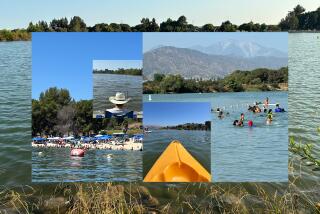Bringing the Pacific Indoors
- Share via
Something fishy is happening in Long Beach. The Aquarium of the Pacific is the newest attraction in theme park-friendly Southern California. Displays explore sea life in the three main habitats of the Pacific Ocean, stretching from the frigid waters of Russia and northern Japan to the tropical South Pacific. Nearly 157,000 square feet of space houses 10,000 fish representing more than 500 species. Among the highlights are a life-size replica of a blue whale with calf and a three-story glass predator tank filled with more than 400 fishes.
Highlights of the Regions
The Great Hall offers previews of the three habitats featured on the second floor:
A. Tropical Pacific: The Palau Islands featured here are home to a variety of brightly colored fishes and coral as well as piped-in tropical scents like coconut and pineapple.
B. Northern Pacific: A rocky zone with surging tide is the first look at the Bering Sea.
C. Southern California and Baja: The predator tank serves as a springboard for entering this habitat. Explore local waters to watch seals and sea lions play and sun themselves off Catalina Island then journey south to Baja and the Sea of Cortez.
*
Predator tank
Designed to show the top-of-the-food-chain fishes found in Southern California waters. Watch for moray eels as they poke their heads out from their rocky lairs.
Windows: 30 feet tall, made from three large pieces of 9-inch-thick acrylic, weighing 7 tons each
Gallons of water: 143,000
Highlight: More than 400 fishes including giant sea bass, sharks, barracuda and yellowtail; microphone-equipped scuba divers explain habitat and fish behaviors
Southern California and Baja exhibits not pictured in drawing (Located on the first level)
Amber Forest: Kelp beds
Nudibranch: Mollusk without a shell
Kelp Camouflage
Two-spot Octopus
California Spiny Lobster
Kelp Contrast
Shark Egg Cases: Eggs will hatch
Sharks in the Forest
Sea Nettles
Moon Jellies: Forty moon jellies drift in large tanks; adjacent videos explain habits.
Moon Jelly Polyps: Stinging jellyfish
California/Baja
Walk through a glass tunnel as seals and sea lions swim overhead off the rocky shoreline of Santa Catalina Island.
Seals & Sea Lions: All have been rescued and rehabiltated; one seal lion is blind. 7-20 feet long
Giant spined sea stars: Uses outstretched arms to clims rocks. 12-15 inches wide
Leopard shark: Unusual appearance makes it hard to find in kelp or on ocean floor. 5 feet long.
Seals & Sea Lions
Gallons of water: 206,000
Highlight: Underwater acrylic tunnel gives close-up views of four seals and four sea lions; exhibit leads to rocky shoreline where seals and sea lions sun themselves.
Kids’ Cove: Ocean-themed playground
*
Up to second level
Discovery Lab: Touch sea urchins, anemones, sea stars and crabs found near Catalina Island; perils of pollution.
Rocky Intertidal: Urchins, sea stars
Sea Turtles: An endangered species
Skates & Rays: Touch different kinds of stingrays
/ Garden Eel
Sea of Cortez: Habitat overview
Northern Pacific
This section is home to some of the aquarium’s most captivating creatures--sea otters. These three were injured and rescued from the Monterey area.
Rockfish (above): A venomous fish whose spine possess a mild toxin. 10-12 inches long.
Giant Japanese spider crab: Roams 6,000 feet deep in the coldest waters. 6 feet wide.
Surge Channels: How tide changes affect sea life
Diving Birds: Puffins and murres
Schooling Fish: Sardines
Giant Pacific Octopus
Gallons of water: 1,330
Highlight: The sight of those eight long arms will make you squirm but adjacent videos show its gentle ways.
Discovery Lab: Learn the safe way to hold a crab; other displays focus on effects of overharvesting.
Sea Otters
Gallons of water: 42,000
Highlights: Three sea otters fish and frolic in a rocky shoreline joined by lingcod and rockfish; exhibit focuses on conservation methods to protect otters.
Abalone & Urchins: What otters eat
Sea Star Diversity
Bays & Sounds: Diverse shorelines
Sculpin & Sea Cucumber: Bottom-feeders
Large Japanese Spider Crab
Gallons of water: 9,030
Highlights: The huge crustacean can measure 6 feet across.
Giant Pacific octopus: Sometimes depicted as monsters by Hollywood, these creatures are actually very shy.
Sea otters: An endangered species, the otter population once numbered in the millions.
Tropical Pacific
One of the world’s premier scuba spots, the Palau archipelago, is featured. It offers a colorful variety of fishes and coral.
Coral Lagoon
Gallons of water: 11,800
Highlights: Above- and below-water viewing of various corals; look for the blue-spotted stingray, colorful Picasso fish and unusual puffer fish.
Upper Reef: First view of largest tank
Gallons of water: 350,000
Highlights: More than 1,000 fishes; divers equipped with microphones swim along and answer questions
Live Coral: Only real coral in the aquarium
Pretty Poison: Some alluring fish can kill
Deadly Disguise: How fish attract prey
Discovery Lab: Examine live coral; conservation focuses on coral reef preservation
Cleaning Stations: Fish grooming
Equal Partners: Symbiotic relationships
Upside-down Jellies
Soft Coral Garden Wall
The Deep Reef
Highlights: Second view of largest tank. This level is reef bottom, where fish and coral are most colorful. Divers feed fish and clean tank.
Sex Reversal: How, why some fish change sex
Sea horses
Stinging Catfish
Sea Snakes
Open Water: Reef is visible but open sea species dominate scene. Watch zebra shark, giant groupers and blacktip reef sharks.
Shark locomotion: How sharks swim
Sunny Exposure: Life at the top of the reef
Cuttlefish
Blue-spotted stingray: Colorful swimmer is easily hidden in vibrant coral reef. 3 feet long and wide
Puffer fish: Like the image its name evokes, this fish puffs up when startled. 2 inches to 2 feet long
Zebra shark: Mild-mannered bottom feeder; sometimes confused with leopard shark because stripes turn to spots as they get older. 5-6 feet long.
Leafy sea dragon: Delicate fish easily mistaken for a flowery plant
/ Tide Surge
The million gallons of Pacific saltwater needed to fill the aquarium exhibits were brought to Long Beach on a barge from waters near Catalina Island. The seawater is processed through a filter to keep it clean and pollution-free. This process is similar to what happens in nature. Tide surges cleanse the habitat of debris and stale water. Several exhibits throughout the aquarium illustrate the process.
Welcome aboard
The big blue boat entrance is the visitors’ cue they are going to sea, and the journey starts at the door. Admission information:
Hours: Seven days per week, 10 a.m.-6 p.m.; evening events planned
General admission: $13.95
Seniors (60 and older): $11.95
Children (ages 3-11): $6.95
Annual passes: Family memberships and group discounts will be available
Information on passes, memberships and discounts: (562) 590-3100 or e-mail [email protected]
On the Net: Take a virtual tour at https://www.aquariumofpacific.org
*
Gift Shop: 4,000 square feet with tribute to Jacques Cousteau
Classrooms: Two wet/dry learning centers
Teacher Resource Center: Provides classroom materials
Theater: Films highlight underwater exploration and the aquarium’s three habitats; features change regularly; seats 192
Cafe Scuba: Indoor or patio dining overlooking Queen Mary; seating for 192
History of Aquariums
The first record of fish being kept is linked to the Sumerians in 2500 B.C.; fish were bred for food. Archeologists have also found evidence of aquariums in the ruins of ancient Greece. The Chinese began domesticating goldfish more than a century ago, during the Song Dynasty. The first public aquarium opened in 1853 at the London Zoo. The first in the U.S. opened in 1856 and was sponsored by P.T. Barnum. The oldest continuously operating U.S. facility is New York City’s Aquarium for Wildlife Conservation, founded in 1896.
Fast Facts
The John G. Shedd Aquarium in Chicago is the world’s largest indoor aquarium, leaving the Long Beach Aquarium of the Pacific in fourth place nationally. A look at the four largest aquariums in the United States:
Shedd Aquarium, Chicago
Opened: 1930
Cost: $3 million
Size: 395,000 square feet
Annual attendance: 2 million
Exhibits: More than 100
Fish: 8,000 representatives of 650 species
Gallons of water: 1 million
*
National Aquarium, Baltimore
Opened: 1981
Cost: $21.3 million
Size: 209,000 square feet
Annual attendance: 1.5 million
Exhibits: 10 major exhibits and 8 smaller ones
Fish: 10,000 representatives of 600 species
Gallons of water: 2 million
*
Monterey Bay Aquarium
Opened: 1984
Cost: $112 million
Size: 322,000 square feet
Annual attendance: 1.7 million
Exhibits: Four major habitats and 100 smaller exhibits
Fish: 300,000 representatives of 571 species
Gallons of water: 1.7 million
*
Long Beach Aquarium of the Pacific
Opens: June 22
Cost: $117 million
Size: 156,735 square feet
Projected annual attendance: 1.6 million
Exhibits: 17 major habitats and 30 smaller exhibits
Fish: 10,000 representatives of 550 species
Gallons of water: 1 million
Faking It
All exhibit habitats are man-made. It took 11 months, 2,500 cubic yards of concrete and 10,000 artificial coral pieces to complete the tanks. None of the kelp, rocks, shells or barnacles are real, either. How a typical habitat was created:
1. Cinder-block form basic design.
2. Flexible hoses create “eel tubes” or caves for fish.
3. Fine mix of concrete, called shotcrete, sprayed over cinder-block
4. Layer of plaster molded to create craggy rock, overhangs
5. Habitat painted; kelp, rocks and shells glued into place; coral base drilled into rock
Tale of the Whale
The Great Hall of the Pacific is dominated by a life-size fiberglass replica of an 88-foot blue whale--the largest animal in the Pacific. A 22-foot calf swims alongside. Fabricating the whale took 10 weeks, and started with a 4-inch-thick steel spine and ribs that form the frame. Layers of various materials were added. The model was shipped from Tucson to Long Beach in pieces. A look inside:
Whale cross-section
Steel spine
Steel ribs
Wire mesh
Foam
Sculpted foam
Fiberglass
Step-by-Step
Part of the aquarium’s main entrance had to be removed so pieces of whale could fit through the door. How the whale was assembled in the Great Hall:
1. Seven pieces link to form mother whale; baby is single piece
2. Seams reglassed; whales sprayed with latex paint
3. Baby whale bolted to mother to prevent swaying damage in case of earthquake
Whale Facts
Weight: 8,375 pounds (mother), 450 pounds (baby)
Longest piece: Mother whale’s head, 12 by 20 feet
Baby whale: Measures 3 by 21 feet
Suspension: 18 cables hold mother whale aloft; three support baby
Water Log
How much water is 1 million gallons? It would take 617 Arrowhead trucks loaded with 324 five-gallon water bottles to fill all the tanks at the Long Beach Aquarium of the Pacific.
Sources: Long Beach Aquarium of the Pacific, Larson Co., John G. Shedd Aquarium, Monterey Bay Aquarium, National Aquarium in Baltimore, Kajima International, Encyclopedia Britannica, World Book Encyclopedia, Arrowhead Water Co.
More to Read
Sign up for The Wild
We’ll help you find the best places to hike, bike and run, as well as the perfect silent spots for meditation and yoga.
You may occasionally receive promotional content from the Los Angeles Times.






